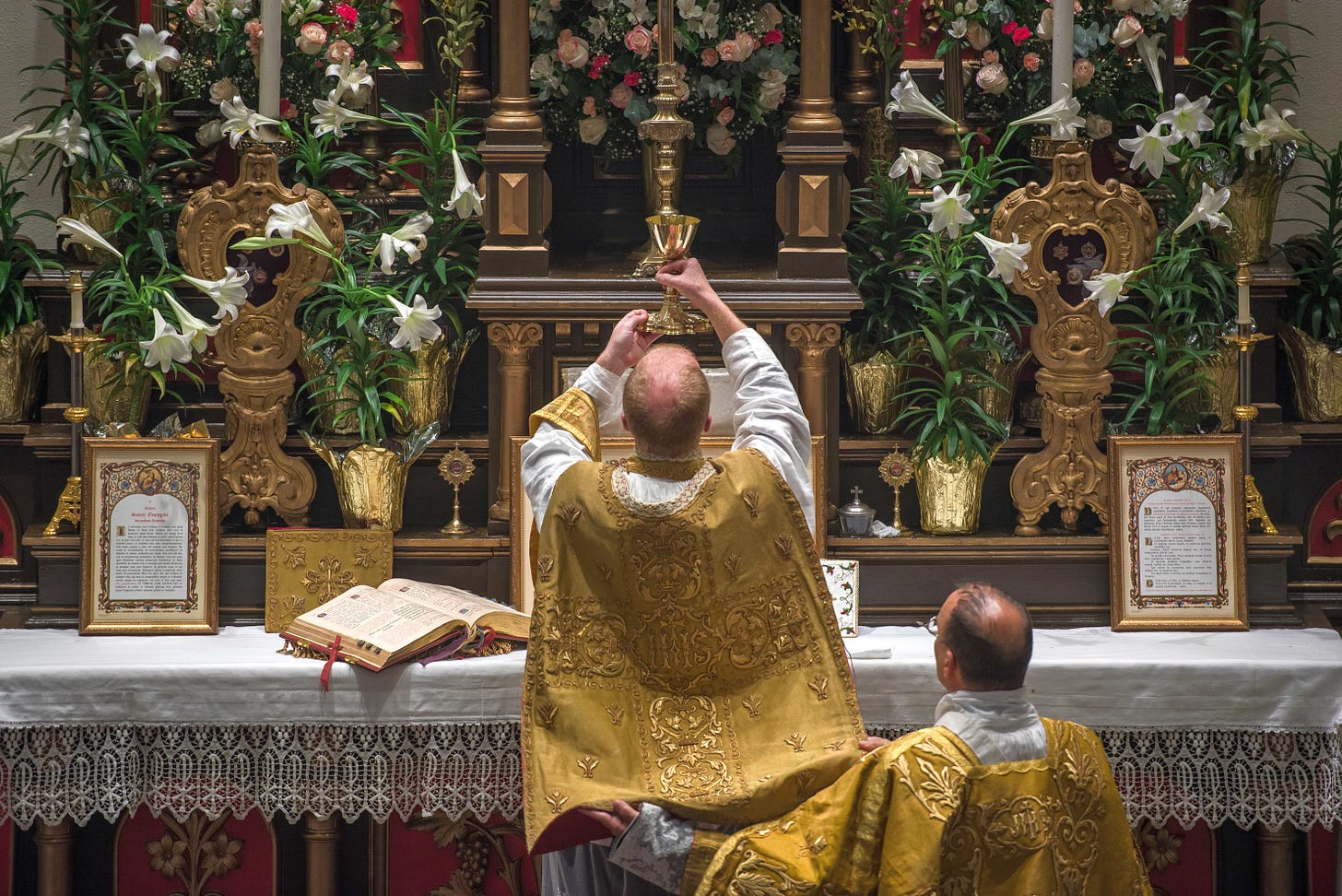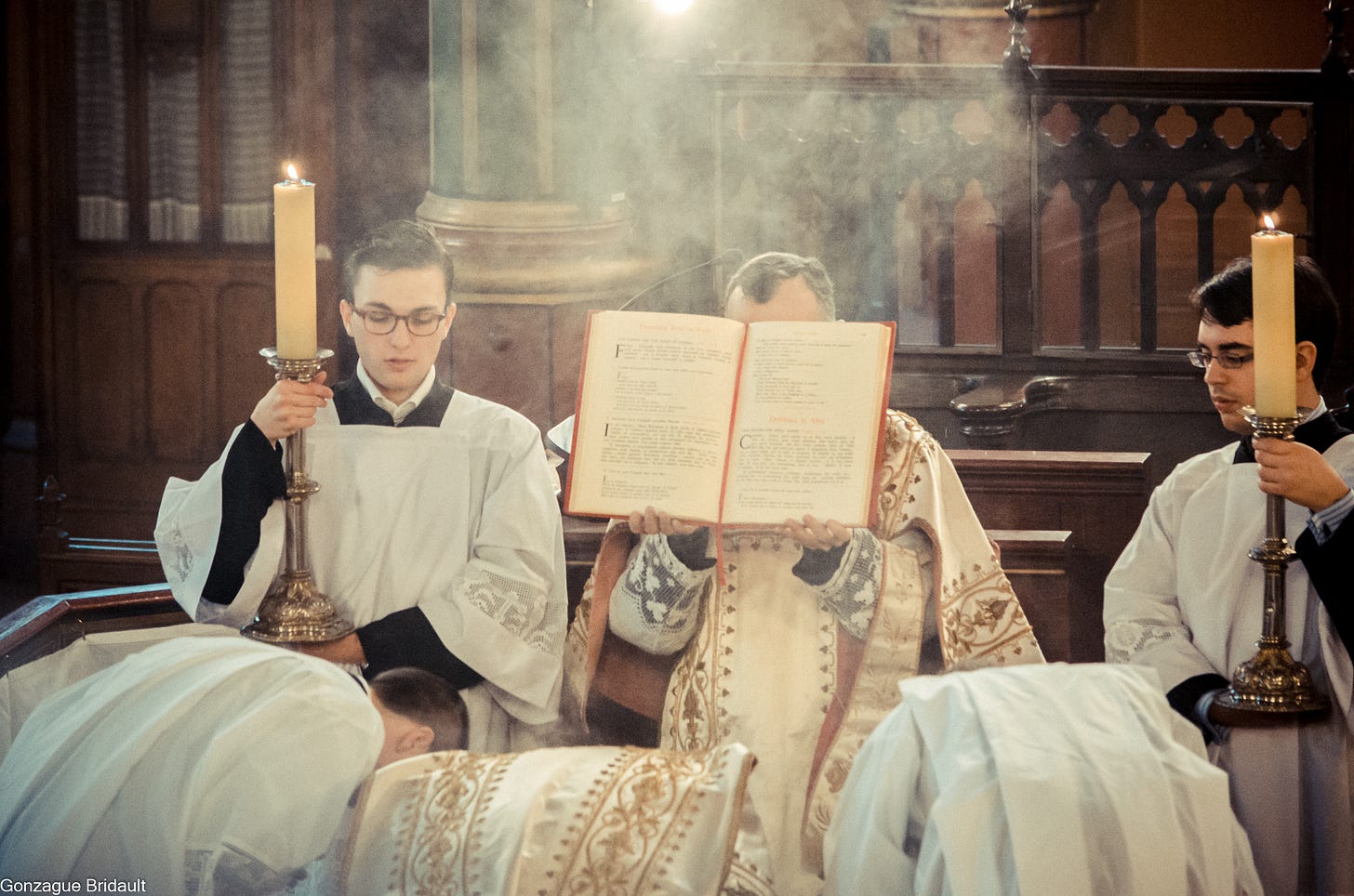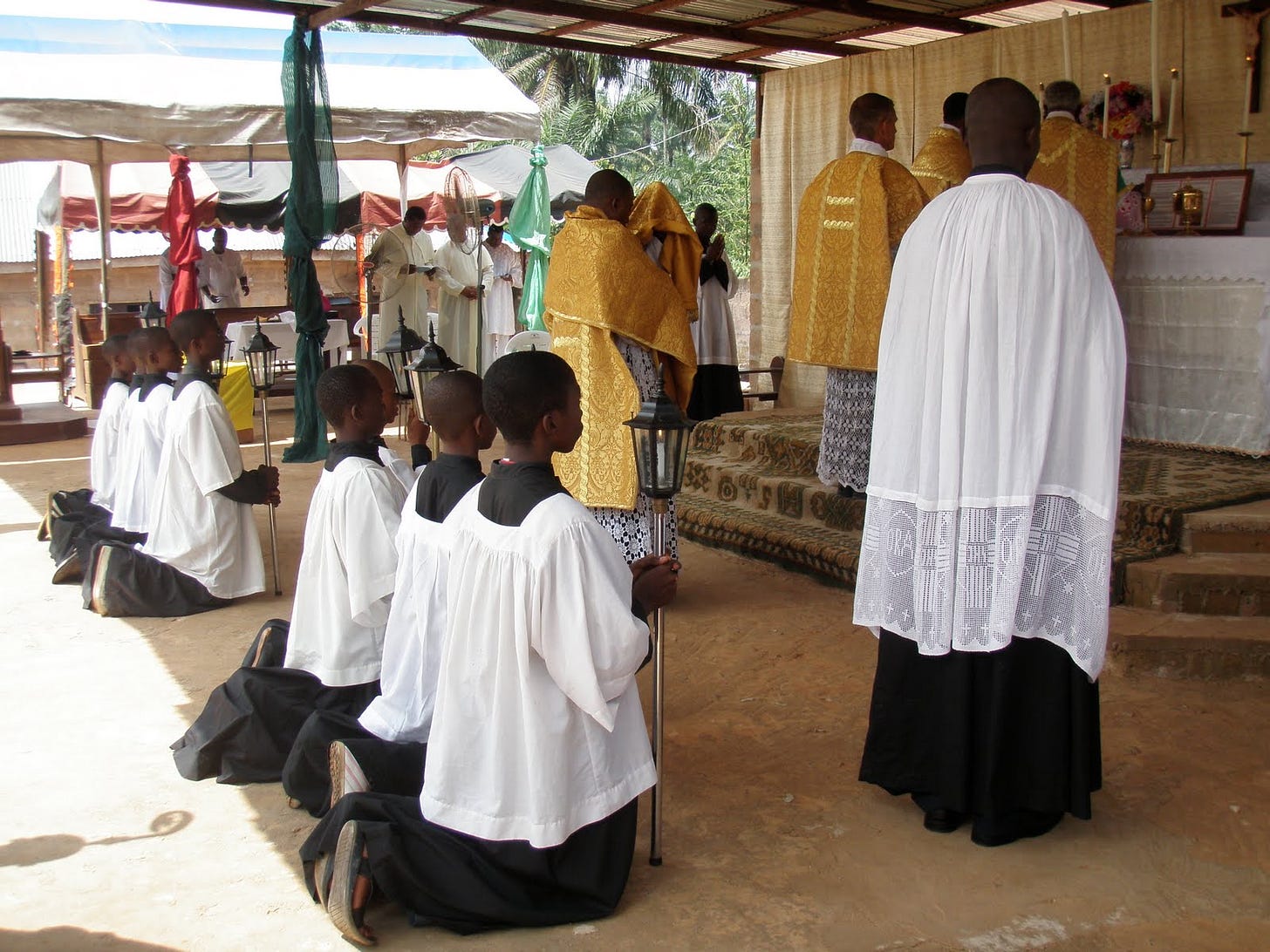Raised in the Fear and Love of God: Why the Traditional Mass Is Good for Children (Part 2)
The venerable Roman rite of Mass is totally focused on the sanctuary, the altar, the sacrifice, the heavenly banquet, the Bread of Angels
Earlier this week, we started our explanation of why it’s so important for parents to prioritize attending the traditional Latin Mass for the sake of their children (and for the good of their own souls). If you haven’t read that post yet, you can find it here. I’ll continue now with reasons 4 through 7.
Fourth, we learn that the Mass is a solemn, serious business.
The venerable Roman rite of Mass is totally focused on the sanctuary, the altar, the sacrifice, the heavenly banquet, the Bread of Angels. It is orderly, disciplined hard work: there is formality, harmony of gesture and words, prayerful concentration. When boys in particular watch the priest’s hard work in the traditional Mass, his painstaking attention to detail and his mastery of the craft, they are impressed: his vocation in life appeals to their awakening manliness. It appeals to the healthy boy’s desire for challenge, accomplishment, and worthwhile sacrifice.
The traditional liturgy gives us both consolation and correction. Unlike modern liturgy, it does not coddle us or put our feelings first. It does not mince up Scripture readings to remove their so-called “difficult verses.” G.K. Chesterton said we need religion not so much to tell us what we are doing right as to tell us what we are doing wrong. There is a gritty realism to the old prayers that acts as a tonic, or like a splash of cold water that wakes us up. They were not written by people with the prejudices, preferences, and blind spots of the modern age, so they pull us out of our comfort zone and challenge us to go deeper in our spiritual life.
The more robust traditional Eucharistic fast, which is either from midnight or for three hours prior to Communion, the “Catholic calisthenics” of sitting, standing, kneeling, and the penance of kneeling for longer periods of time are all forms of training in corporeal discipline. This is something all of us need, but it benefits children in a special way. Which parent has not noticed some general improvements in his little boys when they learn how to serve Mass, or in their little girls as they put on their veils and follow their prayerbooks?
The resplendent clothing of the clergy and the orderly apparel of the altar servers remind everyone who assists at Mass that they should be wearing attire that gives glory to God. Alas, the Church world seems to be following the business world in becoming ever more casual. “Sunday best” is certainly not what it used to be. By its solemnity and seriousness, the Latin Mass fosters awareness of beauty, modesty, and appropriateness.
Fifth, we learn that Christ is the source of our unity and community.
Rather than having a horizontal feel and emphasis, a closed circle of people affirming one another “as church,” at the traditional Mass we orient ourselves vertically to God in adoration, seeking salvation, fellowship, identity, from Him. Above all, the novelty of a simultaneous eruption of the “sign of peace” in the Novus Ordo, which transmits the subliminal message that peace among us gushes up like a geyser from within the human community, is blessedly absent from the Roman rite. Instead, if you are attending a solemn Mass, you will see the original form of the Pax, in which the peace that comes to us from the Lamb of God, truly present on the altar, cascades from Him to the priest, deacon, and subdeacon, who exchange with one another a stylized kiss of peace.
Sixth, we learn that the very words of the Mass are sacred and special.
This truth is powerfully symbolized by the Latin spoken from start to finish (except in the homily, which is not part of the liturgy but an explanation of some aspect of the creed or the readings for the people’s benefit). The use of an archaic language demonstrates, without the need for any explanation, that the liturgy does not belong to the everyday realm, the commonplace, as the use of a modern vernacular suggests. Pertinent as well is the great respect shown to liturgical books throughout the Mass. The altar missal is propped on a gold stand or a pillow, and carried back and forth by the ministers in ceremonial fashion; at solemn Mass, the Epistle and Gospel book is elaborately handled, and, for the Gospel, accompanied by candles and incense. Everything in the old rite is given the most exquisite care, and anything holy is visibly venerated.
Seventh, we learn that the music—especially the chant—is unique and dedicated to God.
The effect of an archaic sacral language is strengthened when the liturgical texts are sung to the subtle melodies of Gregorian chant, whose modes and flowing rhythm make it like nothing else we will encounter in the realm of music. Gregorian chant arose exclusively for divine worship and lends itself to no other use: it is set apart for God. It is the sonic equivalent of incense, chasubles, and golden chalices, which are used only for worship. Such things are the privileged “honor guard” and “attendants” of Christ.
Although Latin and chant can sometimes be found in celebrations of the Novus Ordo, we must remember this crucial point: the foremost beauty given to us in the Church is the beauty of the rite itself, which expands outward to include and inspire other arts. Latin and chant are the clothing of the traditional rite, or better, the “body” that corresponds to its “soul”; they are inseparable properties of the ancient liturgy, through which its essence is expressed—not aesthetic doodads tacked on by a daring pastor.
Moreover, the great heritage of sacred music used in the traditional Mass has the special quality of seeming to emerge from silence and return to it. As any worshiper quickly notices, there is a lot of silence in the old Mass, and this is not something injected into it like a period of rest in between exertions, but a property arising from the more elaborate requirements it places on the priest, whose words and actions are often done quietly. The Roman Rite teaches us the value of silent prayer and adoration, which are superfoods for nourishing faith and devotion.
Eighth, we learn that the Mass goes beyond the local community.
Theoretically, any Mass celebrated among the one billion Catholics of the world is the same Sacrifice of Calvary. However, with the new Mass being said in hundreds of languages, in many conflicting “styles” of worship and music, with the activation of multiple sets of options, the local “flavor” overpowers the recipe, so that there seem to be as many different liturgies as there are celebrating communities. This fosters a negative parochialism comparable to Protestant sects in their thousands.
In contrast, from one end of the Earth to the other, the traditional Latin Mass is offered with the same age-old prayers in the same universal language according to exactly the same rubrics. As children grow up and begin to travel outside their home town, any Latin Mass they find in other cities or other countries will vividly bring home to them the unity and universality of the Church. While tapping into local cultures, the old Mass always transcends the boundaries of nations and the particularity of peoples. Indeed, this transnational divine cultus connects us organically to every generation of the past and of the future until the end of the ages. Its frequent invocations of the holy angels (mostly abolished in the Novus Ordo) draw us into fellowship with the exalted choirs of Heaven who minister in this world while dwelling beyond the realm of mortal flesh.
Ninth, we learn that our religion is something given to us, received by us.
We receive the words of the Mass from tradition, represented by the altar missal; we receive the peace of Christ from the altar; we receive the Holy Eucharist from the anointed hand. The stability and fixity of the rite, and its palpably ancient ethos, strongly convey that the Christian religion preexists us, our intentions, our efforts, our “good ideas”—or lack thereof—and will continue long after we have crumbled to dust. How good it is for modern men to be, for a change, not producers, manufacturers, or inventors, but humble beggars elevated by His gracious will to the King’s high table! His heavenly wedding feast was already in full swing long before we came on to the scene; it will continue forever.
Tenth, we learn that the Mass is the supreme school of prayer.
The traditional Latin liturgy provides an optimal environment for awakening the interior life of the child, offering him an opportunity to settle down, enter into quiet, and discover the meaning and power of adoration and the other acts of prayer.
No one has expressed all this better than the English author Fr. Bryan Houghton, whose literary character Bishop Edmund Forrester describes (obviously in semi-autobiographical manner, in the novel Mitre and Crook) how he learned to pray:
I learned to say my prayers at my mother’s knee—and I still say the same ones each night. But I learned to pray when I was dragged off to Mass on Sundays. Something was altered with Mummy and Daddy. They did not talk to each other or even look at each other. Mummy usually fiddled with a Rosary. Daddy thumbed intermittently a Garden of the Soul which one of my nephews still uses. My eldest sister, Gertrude, who became a Benedictine nun, knelt bolt upright with her eyes usually shut. As I looked around it was the same with all our other relatives and neighbours. What was most unusual was that nobody paid the slightest attention to me. Even if I pulled Mummy’s skirt, she just gently pushed me away. I once tried to climb on Daddy’s back; he lifted me off and put me under the seat. That, too, was strange: although I was in my Sunday best, I was allowed to crawl about the floor provided I did not make a noise. Funny little boy that I was, I realized perfectly well that something was up.
Over there at the altar was Father Gray, a stern old man. I used to hide in the lavatory when he came to visit us. He was dressed in brightly coloured clothes and looked like a fat butterfly. Most of the time he said nothing. He was looking the other way and paid as little attention to Mummy and Daddy as they paid to me.
I do not think I was a particularly precocious child but I was certainly very young when I tumbled to the fact that all these people were praying without saying prayers, as I did. Children are imitative: I too wanted to pray without saying prayers. I opened up to my sister Gertrude. “Just sit quite still, like a good boy,” she said. “You are too small to kneel. Keep your hands still as well, on your thighs. Try not to look round and keep your eyes shut if you can. Then just say ‘Jesus’ under your breath, slowly but constantly. I’ll prod you when you say ‘Thou art my Lord and my God’ and you can say it with me.”
That, mutatis mutandis, is I suppose how we all learned to pray. The point I am getting at is that the Mass itself was our school of prayer. It was there that we learned to be self-effacing, detached, recollected and to adhere to the Divine Presence. It was also at Mass that the simple faithful practiced prayer throughout their lives. They may have known little theology but they prayed as theologians often do not. Moreover, the simplest of them attained to heights of prayer and sanctity far beyond me.
These are a few of the many, many reasons we should always bring our children to the traditional Latin Mass. And what’s good for them is good for us, for all the same reasons.
In a final post on Thursday, I’ll go into some practical matters: how parents can help prepare their children for attending the Latin Mass, and how they can help them participate in it more fruitfully.
Thank you for reading and may God bless you.







I remember my teenaged daughter, leaving one of her first Traditional sung Masses remarked, “I love the silence; and the choir chants, more silent than silence.”
We were recently surprised to see two candles lit instead of six. The parish has three Sung Masses and one or two Low Masses. That day was supposed to be a Sung Mass, and yet, here we were. A lone altar boy emerged from the sacristy with the priest and both went the sanctuary as always.
During the homily, Father expressed regret that we could not have the Sung Mass that day as planned. All the altar boys save one were attending a priestly vocations weekend.
Another time, the faithful were surprised to see all grown men process to the sanctuary. On that day, every altar boy - some six or eight of them - were on a discernment retreat.
It's a good problem to have, and one that I have never seen in fifteen or twenty years as a very active new Mass attendee and server!